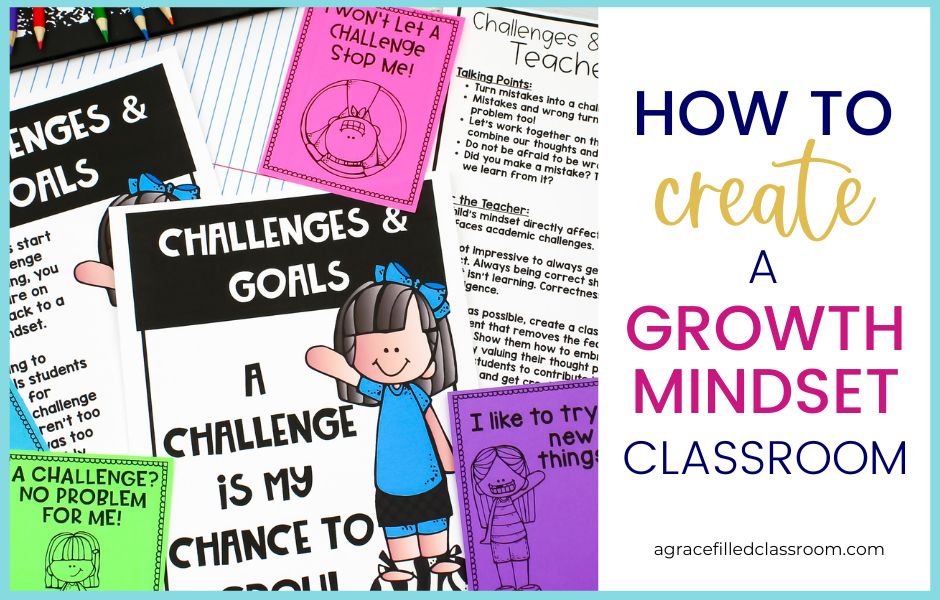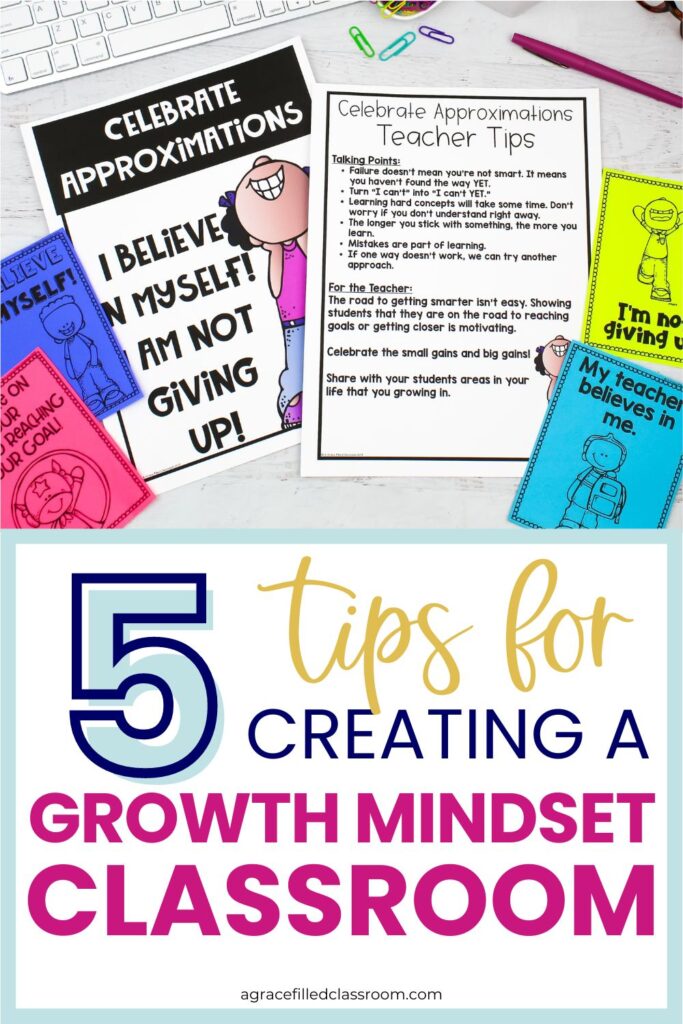One of the best ways to keep students motivated to learn is to show them that they can control how much they learn and grow. They should know that intelligence, talents, and skills are not set in stone. A growth mindset classroom will create this positive attitude toward learning and make your students feel comfortable welcome challenges and take academic risks. Would you like to create a growth mindset community in your classroom this year? I’m sharing some of my favorite tips in this post!

A growth mindset is a belief that intelligence can be grown or developed through effort, persistence, and a focus on learning. In contrast, a fixed mindset is a belief that intelligence, talents, and skills are predetermined.
After hearing about the difference between growth and fixed mindset, you can probably guess which is best for your students. Instead of having a fixed mindset, children should know that they can learn anything with effort and persistence! This one shift in perspective will make a huge difference in keeping students motivated to work hard on challenging tasks in your classroom.
If you want to focus more effort on developing a growth mindset classroom, keep reading! I’m sharing five things that you can do to encourage growth mindset in your classroom. These tips will help you create a positive classroom environment where students feel safe to take academic risks and challenge themselves.
The first step is to have age-appropriate discussions with your students about how the brain works. A growth mindset classroom is one that talks openly and frequently about the brain and its role in learning.
When students understand how the brain grows through making connections, they will develop a growth mindset! They will understand that even mistakes can help the brain grow and develop. Remind students that when something is easy, their brain is not learning. It’s important for the brain to experience challenging tasks!
Another important concept to teach students is that the brain gathers information through all five senses. Be sure to provide learning opportunities that encourage students to use all of their senses. Then remind them that these learning tasks are helping the brain make stronger connections.
Once students understand that the brain needs to be challenged in order to make connections, it’s time for the next step! As students work on challenging tasks, be sure to praise them for their efforts. When you wait to praise students until they have completed a task correctly, you could be missing a chance to give them powerful feedback.
Instead, be sure to praise students for their effort and perseverance when working on challenging tasks. This makes students more willing to welcome learning opportunities. It will also help them understand that correctness does not equal intelligence.
After students have had a chance to understand the power of their brains and the benefits of challenges, they should set goals to welcome those challenges. Students with a fixed mindset are resistant to setting goals or will set simple goals that they can reach easily. As you develop a growth mindset community in your classroom, be sure to invite your students to set challenging goals for themselves.
As students work toward their goals, be sure to emphasize the power of “yet!” They are working toward learning something that they don’t know…yet. They have set a goal to be able to do something they can’t do…yet. When students make progress toward their goals, no matter how small, celebrate those accomplishments! Remind students that learning and growth take time. The longer they stick with it, the more they will learn in the process.
Be sure to include parents and families in your efforts to create a growth mindset community! A strong school-home connection will be an important asset as you create a positive classroom environment. At the beginning of the year, you can provide parents with information about growth mindset. Invite them to help their child embrace challenges and celebrate both small gains and big wins throughout the year!
You can send home positive notes to show parents the growth their child is experiencing at school. There is no need to wait for perfectly-completed assignments to send home a positive note! If a student persisted in a very challenging assignment, send home a note to share this great news with parents.
Finally, your example plays an important role in developing a growth mindset community in your classroom. When you experience something challenging, point it out to your students. Explain when you are sticking with a task instead of giving up. Celebrate your own small wins just as you do for your students!
By using growth mindset language in the classroom, you will support your students as they develop their own inner monologue. It will help them to see that the brain never stops making connections and learning new things. Your students will be more likely to develop a growth mindset when they see those same attributes in you!
Are you looking for resources to help you create a growth mindset community in your classroom? I have created a resource with growth mindset notes and posters that you can use to support your students. You can use these printable notes to recognize your students’ efforts to develop and maintain a growth mindset.
If you’d like to take a closer look at this resource, you can find it in my website shop or on Teachers Pay Teachers.
If you’d like to return to these tips later, be sure to add this pin to your favorite teaching board on Pinterest. You’ll be able to quickly find this post the next time you’re looking for growth mindset tips and resources for your classroom.

 Teaching in a primary classroom can be overwhelming! Have you ever wondered… How can I meet all the demands of teaching and still make sure I am teaching my students to be good world citizens? How can …
Teaching in a primary classroom can be overwhelming! Have you ever wondered… How can I meet all the demands of teaching and still make sure I am teaching my students to be good world citizens? How can … A Grace-Filled Classroom is a participant in the Amazon Services LLC Associates Program, an affiliate advertising program designed to provide a means for sites to earn advertising fees by advertising and linking to Amazon.com.
Copyright © 2024 A GRACE-FILLED CLASSROOM | Terms and Conditions